Intel Haswell-EP Xeon 12 Core Review: E5-2650L V3 and E5-2690 V3
by Ian Cutress on November 6, 2014 9:00 AM EST- Posted in
- CPUs
- IT Computing
- Intel
- Xeon
- Enterprise
- LGA2011-3
- Haswell EP
Linux Performance
Built around several freely available benchmarks for Linux, Linux-Bench is a project spearheaded by Patrick at ServeTheHome to streamline about a dozen of these tests in a single neat package run via a set of three commands using an Ubuntu 14.04 LiveCD. These tests include fluid dynamics used by NASA, ray-tracing, OpenSSL, molecular modeling, and a scalable data structure server for web deployments. We run Linux-Bench and have chosen to report a select few of the tests that rely on CPU and DRAM speed.
Unfortunately due to the different time windows we had these CPUs and the time of introduction of Linux-Bench into the normal testing suite, we only have results for the 2P and 1P E5-2650L V3 configurations.
C-Ray: link
C-Ray is a simple ray-tracing program that focuses almost exclusively on processor performance rather than DRAM access. The test in Linux-Bench renders a heavy complex scene offering a large scalable scenario.
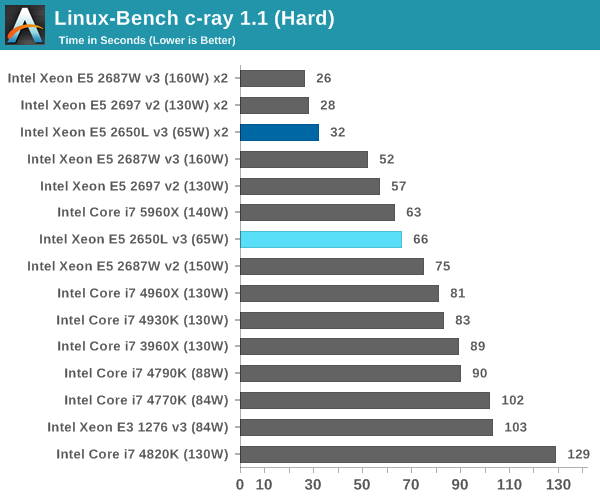
p7zip Compression and Decompression
7-Zip is a common open source compression and decompression tool for data transfer.
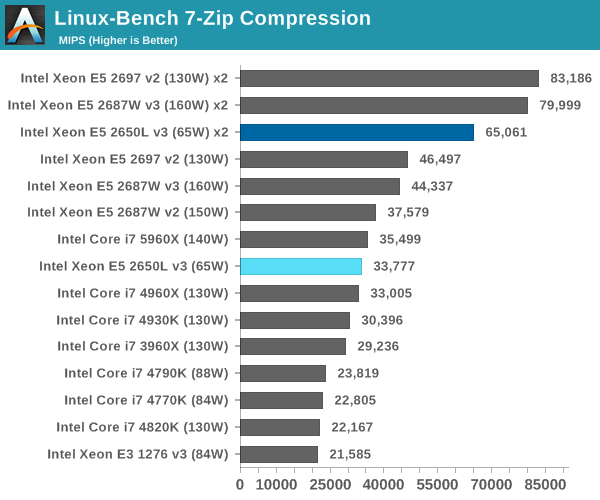
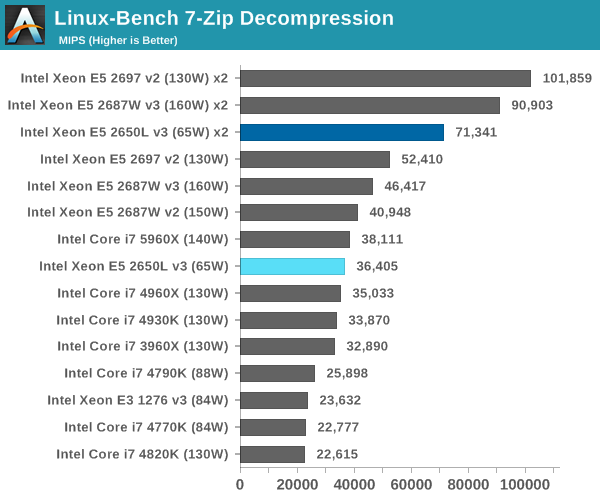
NAMD, Scalable Molecular Dynamics: link
Developed by the Theoretical and Computational Biophysics Group at the University of Illinois at Urbana-Champaign, NAMD is a set of parallel molecular dynamics codes for extreme parallelization up to and beyond 200,000 cores. The reference paper detailing NAMD has over 4000 citations, and our testing runs a small simulation where the calculation steps per unit time is the output vector.
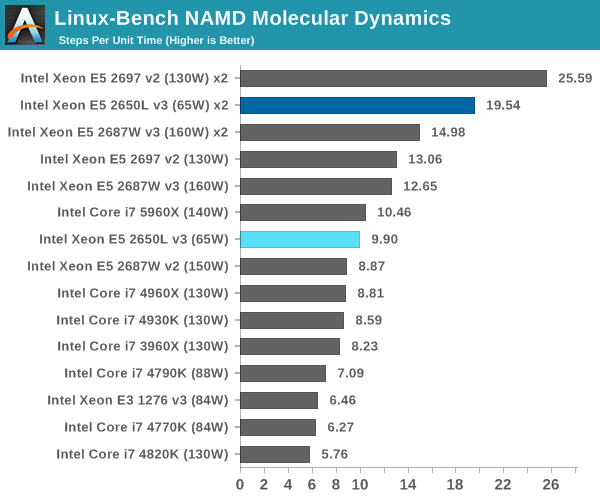
NPB, Fluid Dynamics: link
Aside from LINPACK, there are many other ways to benchmark supercomputers in terms of how effective they are for various types of mathematical processes. The NAS Parallel Benchmarks (NPB) are a set of small programs originally designed for NASA to test their supercomputers in terms of fluid dynamics simulations, useful for airflow reactions and design.
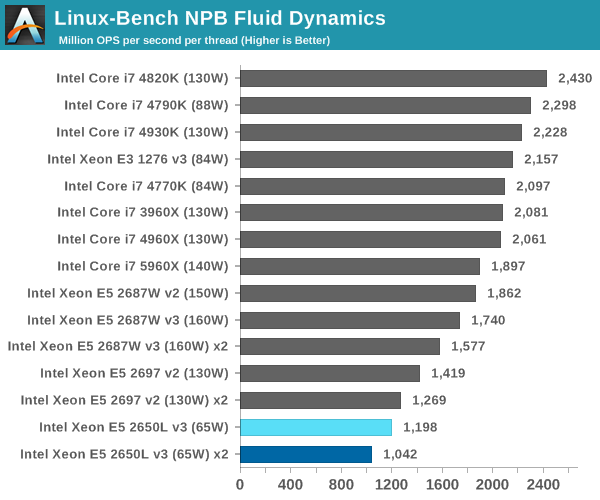
OpenSSL Sign/Verify
OpenSSL is the platform that secures the majority of the websites we visit, and being able to issue/verify this security is paramount to performance. We test the rates at which OpenSSL certificates are signed and verified.
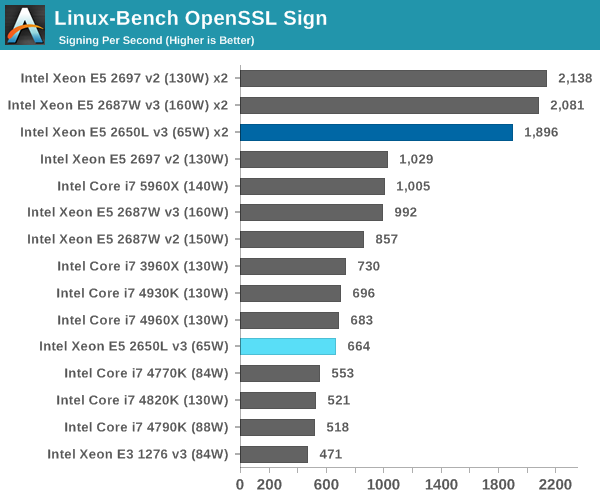
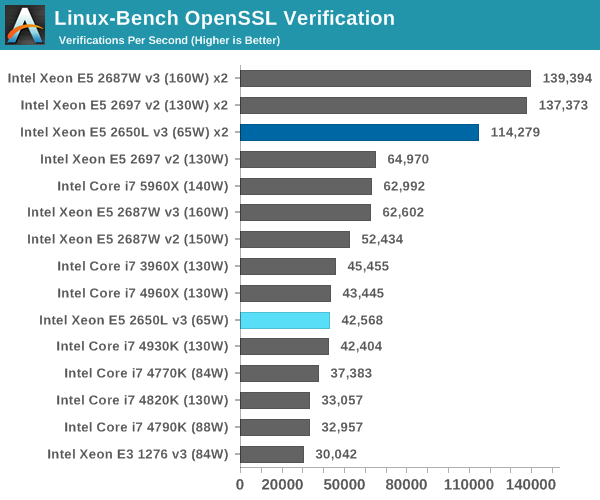
Redis: link
Many of the online applications rely on key-value caches and data structure servers to operate. Redis is an open-source, scalable web technology with a srtong developer base, but also relies heavily on memory bandwidth as well as CPU performance.
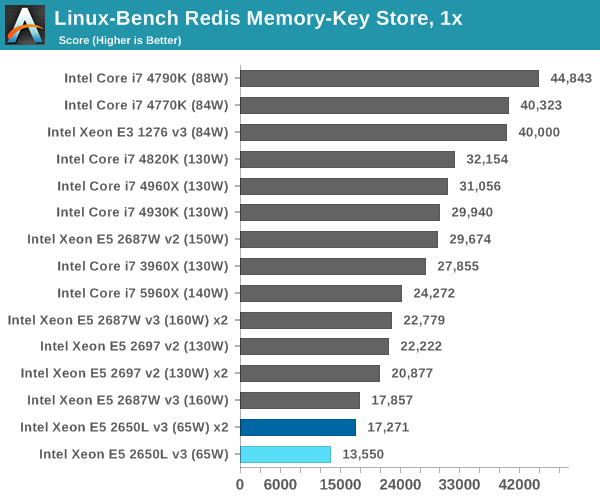
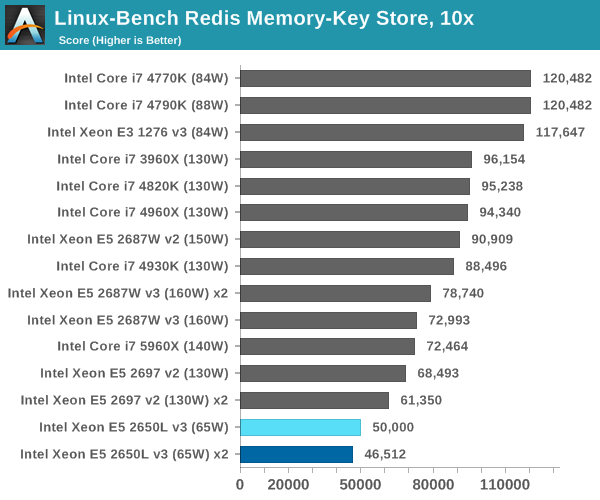
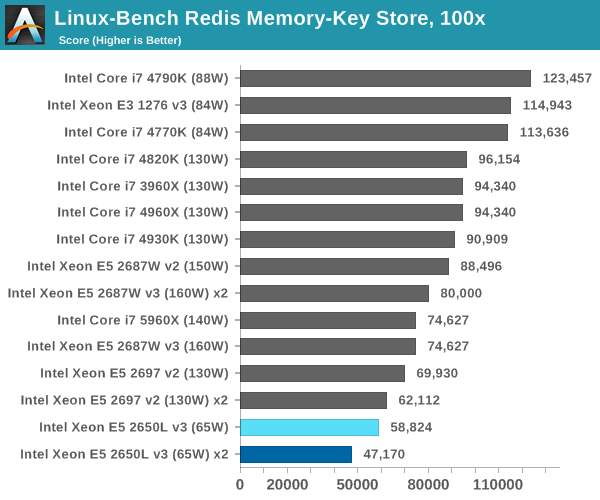










52 Comments
View All Comments
SanX - Thursday, November 6, 2014 - link
All that is secondary to production cost. Trying to emphasize that the production cost of Intel chips is barely 30-50 bucks at the most. Probably much less since those mibile chips still get the profit. Some 4 core mobile chips with 1 billion transistors are already sold for 4 dollars and still bring the profitDeath666Angel - Sunday, November 9, 2014 - link
Those guys do not invest anything in R&D and the chips are much smaller due to less complex cores and uncore areas.dragonsqrrl - Thursday, November 6, 2014 - link
Trollololololruthan - Thursday, November 6, 2014 - link
Very great article theme, i can complain about some particular things in article, but in general im really grateful that such article exist at all.ruthan - Thursday, November 6, 2014 - link
To results, i would like to see comparison 65W Xeon with Core i7 architecture -65W model - 4590S head to head.In comparison Core i7 3770k - for 320$ and this 1320$ is 1000 bucks for what?
+ 25% of performance in most of multi threaded benchmarks and - 5% in gaming and generally limited mainboard choice and + for ECC memory.
If there would be +50% in multithreaded apps i would consider Xeon for my workstation, otherwise it does make no sense. 12 weak cores is nothing to be excited, or my good for some web, DB server, or visualization - here im still curious about results.
LeptonX - Thursday, November 6, 2014 - link
Something wrong with the results they seem inconsistent, why doesn't 2687W v3 mop the floor with 5960X? By all means it should as it have both more cores and more cache, yet it loses to the i7 by a quite significant margin sometimes. Is that the result of using the bigger die which is quite different in cores arrangement and also have bigger but slower cache. Still, I think it should win practically everywhere and yet it even manages to loses to its predecessor(2687 V2) in Linux-Bench NPD FD and the margin of victory of 5960X is strangely high. Were they tested in different motherboards or even with MCE enabled on 5960X and disabled on 2687W V3? How can you explain those results?Ytterbium - Friday, November 7, 2014 - link
MCE doesn't work with Xeon's I have 2687 V2 & had 4960x, so it could be that.kordian - Thursday, November 6, 2014 - link
Why are you guys doing gaming benchmarks on server processors? No one is buying $2500 processors for gaming when a $500-$1000 i7 will do just as well or better at it.Where are the server workload benchmarks that used to accompany Xeon reviews? I want database benchmarks, not Tomb Raider benches.
Also, the power delta is stupid/useless, as others have pointed out. Higher deltas could mean less efficient, or better at idling, and there's no way to tell which is which.
esterhasz - Friday, November 7, 2014 - link
Yeah, this is a strange review. Browser benchmarks? Games? Send the chips to Johan already.Samus - Thursday, November 6, 2014 - link
Man that's an amazing CPU for $2000...